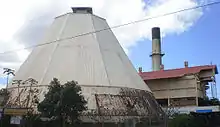Waialua Sugar Mill
The Waialua Sugar Mill is a historical sugar refinery located in the town of Waialua on the North Shore of Oahu.

History
In 1865, Levi and Warren Chamberlain started a sugarcane plantation in Waialua that ultimately failed,[1] and Robert Halstead bought the Chamberlain plantation in 1874 under the partnership of Halstead & Gordon. Gordon died in 1888, and the plantation was managed by the Halstead Brothers, Robert and his two sons, Edgar and Frank.[2] In 1898, Castle & Cooke formed the Waialua Agricultural Company and purchased the plantation from the Halstead Brothers.[2][3]
By the end of 1898, a new mill was constructed, and the first crop harvested in 1899, producing 1,741 tons of sugar.[3] Castle & Cooke also expanded the acreage, built a railway system, and maximized ground and surface water storage and irrigation systems.[1] Between 1900 and 1906, four surface water collection systems were constructed, giving the Waialua sugar plantation the largest water storage capacity in the state of Hawaii.[4][5] As a result of these efforts, sugar production increased from less than 5000 to 20,000 tons from 1900-1905.[1] Mechanical loading of harvested cane began to replace manual labor using self-propelled machines in 1920.[6] Later, the Waialua plantation would co-generate electricity and sell it to local communities, contributing a small percentage to Hawaii's energy production.[7]
The Waialua Sugarmill and lands was acquired by Castle & Cooke one of Hawaii's Big Five trading and sugar industry management companies.
By 1991, the mill was producing eight percent of sugar in Hawaii as the Waialua Sugar Company, a subsidiary of the Dole Food Company.[8] However, the plantation was unable to increase the tons of sugar per acre yields.[9] The Waialua Sugar Mill finally closed in October, 1996 due to profit concerns and was the last sugarcane plantation on the island of Oahu to close.[3][8] By 1999, the old sugar workers camp was still inhabited by former Filipino laborers.[10] The area currently serves as an industrial park for the North Shore of Oahu.
Notes
- Wilcox 1998, p. 108.
- Dorrance & Morgan 2000, p. 42.
- Dorrance & Morgan 2000, pp. 47-49.
- Wilcox 1998, p. 109.
- Kirch & Sahlins maintain that the clearing of land by the Waialua Agricultural Company was responsible for the destruction of the surface archaeological record in Waialua, in particular a pondfield system originally used by prehistoric Hawaiians, considered by J. Gilbert McAllister as "the longest irrigation ditch of which there is any memory". Several Hawaiian temples (heiau) in the area had also been destroyed by 1933. See Kirch, P.V. Sahlins, M.D. (1992) Anahulu: The Anthropology of History in the Kingdom of Hawaii. University of Chicago Press. ISBN 978-0-226-73366-1.
- Dorrance & Morgan 2000, p. 184.
- Dorrance & Morgan 2000, p. 172.
- Dorrance & Morgan 2000, pp. 141-142
- Dorrance & Morgan 2000, p. 202.
- Dorrance & Morgan 2000, p. 133.
References
- Dorrance, William H.; Morgan, Francis S. (2000), Sugar Islands: The 165-Year Story of Sugar in Hawaiʻi (First ed.), Honolulu, Hawaii: Mutual Publishing, ISBN 1-56647-503-1
- Wilcox, Carol (1998), Sugar Water: Hawaii's Plantation Ditches, University of Hawaii Press, ISBN 0-8248-2044-4